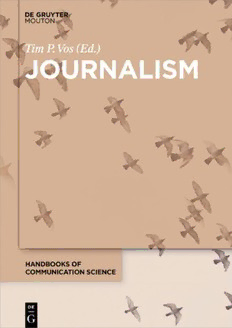
Journalism PDF
Preview Journalism
TimP.Vos(Ed.) Journalism Handbooks of Communication Science Edited by Peter J. Schulz and Paul Cobley Volume 19 Journalism Edited by Tim P. Vos ThepublicationofthisserieshasbeenpartlyfundedbytheUniversitàdellaSvizzera italiana–UniversityofLugano. ISBN978-1-5015-1038-0 e-ISBN(PDF)978-1-5015-0008-4 e-ISBN(EPUB)978-1-5015-0010-7 ISSN2199-6288 BibliographicinformationpublishedbytheDeutscheNationalbibliothek TheDeutscheNationalbibliothekliststhispublicationintheDeutscheNationalbibliografie; detailedbibliographicdataareavailableontheInternetathttp://dnb.dnb.de. ©2018WalterdeGruyterInc.,Boston/Berlin Coverimage:OliverRossi/Photographer’sChoiceRF/Gettyimages Typesetting:MetaSystemsPublishing&PrintservicesGmbH,Wustermark Printingandbinding:CPIbooksGmbH,Leck www.degruyter.com Preface to Handbooks of Communication Science series This volume is part of the series Handbooks of Communication Science, published from 2012 onwards by de Gruyter Mouton. When our generation of scholars was in their undergraduate years, and one happened to be studying communication, a series like this one was hard to imagine. There was, in fact, such a dearth of basic and reference literature that trying to make one’s way in communication studies as our generation did would be unimaginable to today’s undergraduates in the field. In truth, there was simply nothing much to turn to when you needed tocastafirstglanceatthekeyobjectsinthefieldofcommunication.Thesituation in the United States was slightly different; nevertheless, it is only within the last generationthatthebasicliteraturehasreallyproliferatedthere. What one did when looking for an overview or just a quick reference was to turntosocialsciencebooksingeneral,ortothehandbooksortextbooksfromthe neighbouring disciplines such as psychology, sociology, political science, linguis- tics, and probably other fields. That situation has changed dramatically. There are more textbooks available on some subjects than even the most industrious undergraduate can read. The representative key multi-volume International Ency- clopedia of Communication has now been available for some years. Overviews of subfields of communication exist in abundance. There is no longer a dearth for the curious undergraduate, who might nevertheless overlook the abundance of printed material and Google whatever he or she wants to know, to find a suitable Wikipediaentrywithinseconds. ‘Overviewliterature’inanacademicdisciplineservestodrawabalance.There hasbeenademandandanecessitytodrawthatbalanceinthefieldofcommuni- cation and it is an indicator of the maturing of the discipline. Our project of a multi-volume series of Handbooks of CommunicationScience is a part of this com- ing-of-age movement of the field. It is certainly one of the largest endeavours of its kind within communication sciences, with almost two dozen volumes already planned.Butitisalsouniqueinitscombinationofseveralthings. The series is a major publishing venture which aims to offer a portrait of the current state of the art in the study of communication. But it seeks to do more than just assemble our knowledge of communication structures and processes; it seekstointegratethisknowledge.Itdoessobyofferingcomprehensivearticlesin allthevolumesinstead ofsmallentriesinthestyle ofanencyclopedia.Anexten- sive index in each Handbook in the series, serves the encyclopedic task of find relevant specific pieces of information. There are already several handbooks in sub-disciplinesofcommunicationsciencessuchaspoliticalcommunication,meth- odology,organisationalcommunication–butnonesofarhastriedtocomprehen- sivelycoverthedisciplineasawhole. https://doi.org/10.1515/9781501500084-202 vi PrefacetoHandbooksofCommunicationScienceseries For all that it is maturing, communication as a discipline is still young and one of its benefits is that it derives its theories and methods from a great variety ofworkinother,andoftenolder,disciplines.Oneconsequenceofthisisthatthere is a variety of approaches and traditions in the field. For the Handbooks in this series,thishascreatedtwonecessities:commitmenttoapluralismofapproaches, andacommitmenttohonourthescholarlytraditionsofcurrentworkanditsintel- lectualrootsintheknowledgeinearliertimes. There is really no single object of communication sciences. However, if one weretopositonepossibleobjectitmightbethehumancommunicativeact–often conceived as “someone communicates something to someone else.” This is the departure point for much study of communication and, in consonance with such study,itisalsothedeparturepointforthisseriesofHandbooks.Assuch,theseries doesnotattempttoadopttheuntenablepositionofunderstandingcommunication sciences as the study of everything that can be conceived as communicating. Rather, while acknowledging that the study of communication must be multi- facetedorfragmented,italsorecognizestwoverygeneralapproachestocommuni- cationwhichcanbedistinguishedas:a)thesemioticorlinguisticapproachassoci- ated particularly with the humanities and developed especially where the Romance languages have been dominant and b) a quantitative approach associ- ated with the hard and the social sciences and developed, especially, within an Anglo-Germantradition.Althoughtherelationshipbetweenthesetwoapproaches and between theory and research has not always been straightforward, the series does not privilege one above the other. In being committed to a plurality of approaches it assumes that different camps have something to tell each other. In thisway,theHandbooksaspiretoberelevantforallapproachestocommunication. The specific designation “communication science” for the Handbooks should be takentoindicatethiscommitmenttoplurality;like“thestudyofcommunication”, it merely designates the disciplined, methodologically informed, institutionalized studyof(human)communication. On an operational level, the series aims at meeting the needs of undergradu- ates,postgraduates,academicsandresearchersacrosstheareaofcommunication studies. Integrating knowledge of communication structures and processes, it is dedicatedtoculturalandepistemologicaldiversity,coveringworkoriginatingfrom around the globe and applying very different scholarly approaches. To this end, the series is divided into 6 sections: “Theories and Models of Communication”, “Messages, Codes and Channels”, “Mode of Address, Communicative Situations and Contexts”, “Methodologies”, “Application areas” and “Futures”. As readers willsee,thefirstfoursectionsarefixed;yetitisinthenatureofourfieldthatthe “Applicationareas”willexpand.Itisinevitablethatthefuturesforthefieldprom- ise to be intriguing with their proximity to the key concerns of human existence onthisplanet(andevenbeyond),withthecontinuingprospectincommunication sciencesthatthatfutureisincreasinglysusceptibleofprediction. PrefacetoHandbooksofCommunicationScienceseries vii Note: administration on this series has been funded by the Università della Svizzeraitaliana–UniversityofLugano.Thanksgotothepresidentoftheuniver- sity, Professor Piero Martinoli, as well as to the administration director, Albino Zgraggen. PeterJ.Schulz,UniversitàdellaSvizzeraitaliana,Lugano PaulCobley,MiddlesexUniversity,London Acknowledgements This volume could not have happened without the leadership and support of the series editors of the Handbooks of Communication Science, Peter J. Schulz and Paul Cobley. Likewise, the able and determined work of Barbara Karlson at De Gruyter Mouton has kept this handbook on track. This handbook represents a mountainofwork. Tatsiana Karaliova, now at Butler University, largely managed the day-to-day duties on this volume. Her hard work, eye for detail, and passion for the project hasmadethisafarbettervolumethanitotherwisewouldhavebeen.Othersatthe UniversityofMissouriSchoolofJournalismhaveaidedinthebook,notablyJoseph Moore and Carlos A. Cortés-Martínez. Meanwhile, Liz Nichols performed excellent copyeditingservices. The 37 authors who have had a hand in writing the chapters of this volume are truly exceptional scholars. They have produced intellectual work that is crea- tive, thought provoking, and forward looking. They value the practice of journal- ismandcareaboutthefieldofjournalismstudies.Thiscomesthroughinthecare- fulscholarshipweseeinthisvolume.Afewoftheauthorsendedupwritingtheir chaptersonveryshortnoticeaftercolleaguesneededtostepbackfromtheproject. The quality of work certainly did not suffer. Likewise, this handbook has been muchimprovedbythethoroughandinsightfulworkofmorethantwo-dozenanon- ymousreviewers.Reviewersprovidedprobingquestionsandwellconsideredsug- gestions. As is often the case in academia, it takes much selfless work to create collectivesuccess. Allofwhichistosay,manyhavehadahandtoproducingthishandbookand makingsureitisavaluablecontributiontothefieldofjournalismstudies.During this work, I have been inspired by my colleagues, both at Missouri and in the broadercommunityofjournalismstudies,whomaintainapassionfortheoretically richandcompellingscholarship.Ihavealsobeeninspiredbythemenandwomen who practice journalism in the face of difficult circumstances. Reporting, writing, editing, and other forms of journalistic labor are far too often under appreciated. Myinspirationwastoproduceahandbookthatdidjusticetothepassionandpro- fessionalismofjournalistsandjournalismscholarsaroundtheworld. Finally,myfamilyisanunendingsourceofinspiration.Ihavebeenblessedto beclosetointelligentandcreativefamilymembers.Suzette,Trevor,andEthanVos havebothliterallyandfigurativelycajoledmeupmountains.Amountainofwork, itturnsout,canalsobealaboroflove. Columbia,Missouri,December2017 TimP.Vos https://doi.org/10.1515/9781501500084-203
